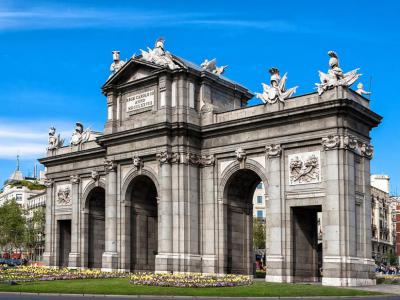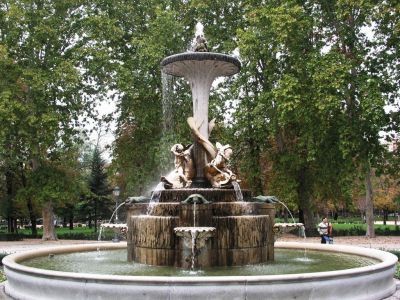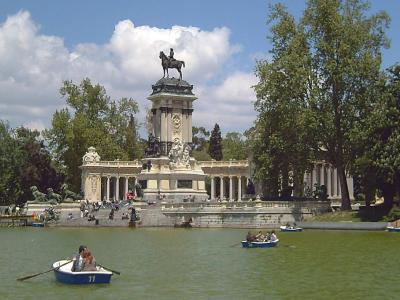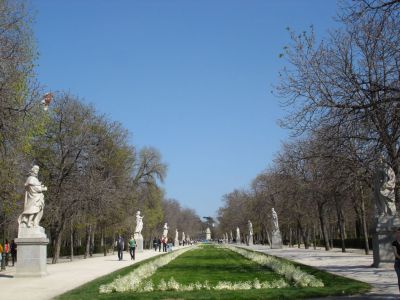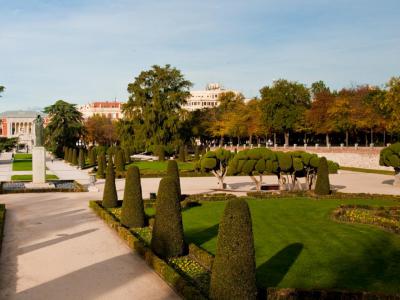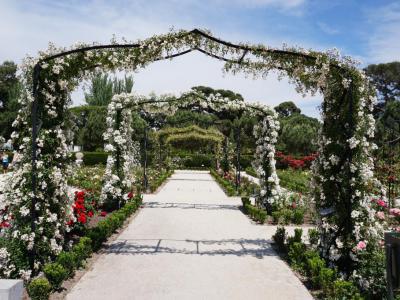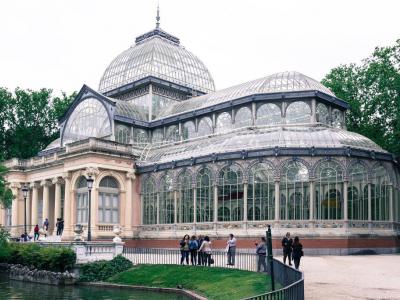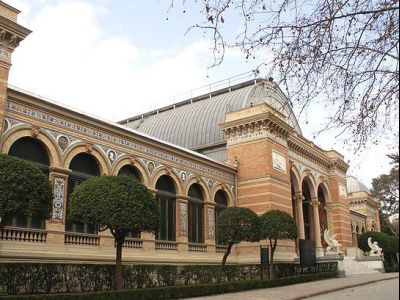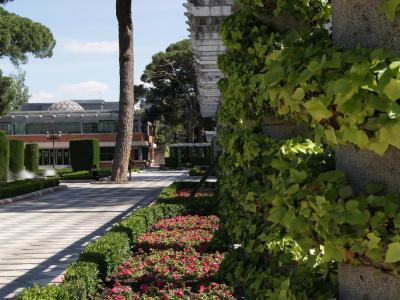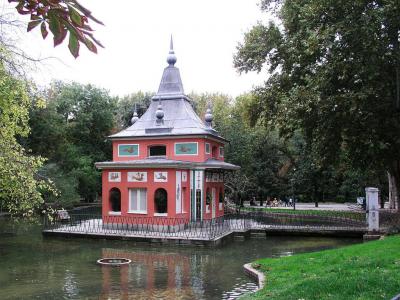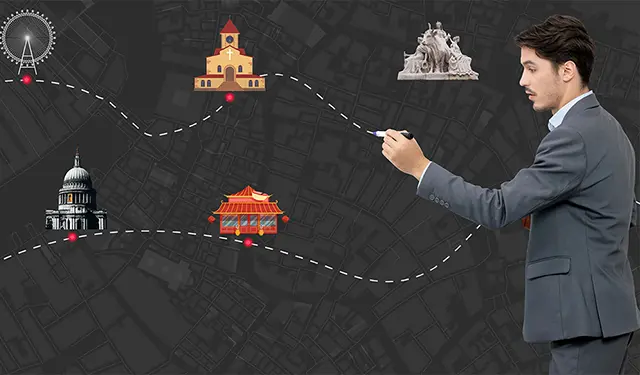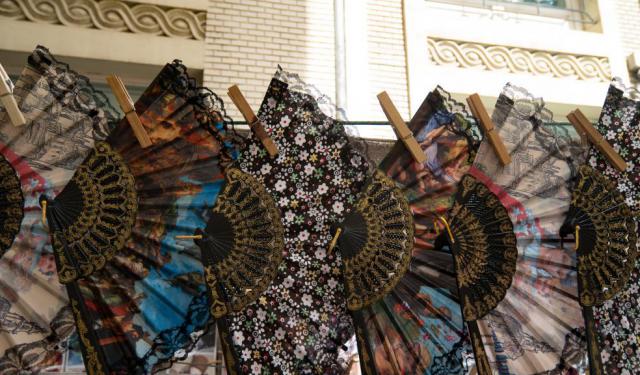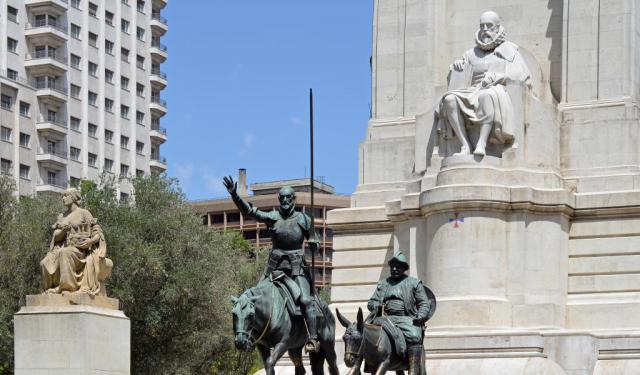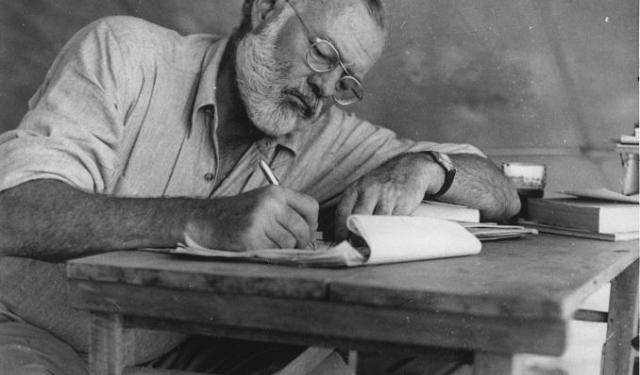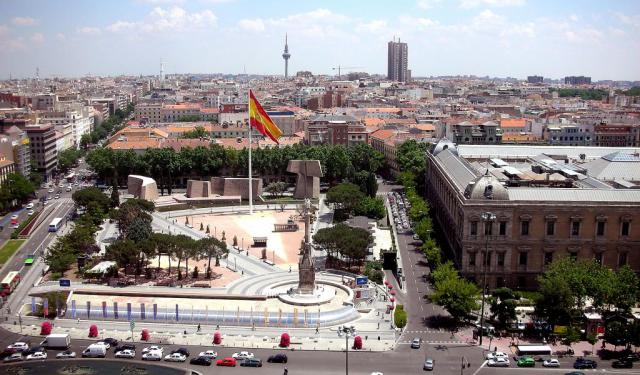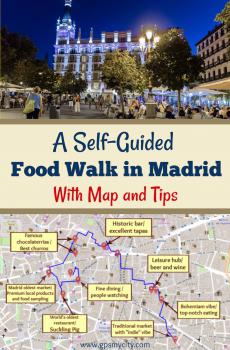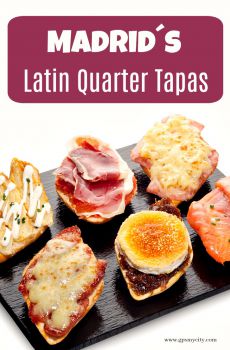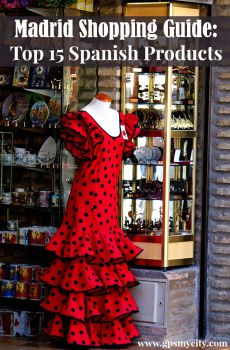
Buen Retiro Park Walking Tour (Self Guided), Madrid
Buen Retiro—meaning “Pleasant Retreat”—is one of Madrid’s most beloved landmarks. Much like Central Park in New York or Hyde Park in London, this former royal escape has become the city’s most iconic green space, a peaceful oasis right in the heart of the Spanish capital.
Among its standout attractions is the Crystal Palace, a stunning 19th-century glass and iron structure that now hosts rotating contemporary art exhibitions under the Queen Sofía National Museum. Not far off, you’ll find the Velázquez Palace—another elegant exhibition space steeped in history.
At the center of the park is Pleasure Lake, where you can rent a rowboat and drift past the grand monument to King Alfonso XII, framed by sweeping colonnades and detailed sculptures. Garden enthusiasts will love La Rosaleda, the rose garden that blooms beautifully in spring, and the Parterre Garden, home to Madrid’s oldest tree—a Montezuma cypress planted in 1632.
As you stroll through the paths, you’ll encounter fountains, statues, and delightful surprises like the Fisherman’s House and the Fountain of the Fallen Angel—a rare tribute to Lucifer, inspired by John Milton’s “Paradise Lost”. And if you head toward the Cecilio Rodríguez Gardens, keep an eye out for peacocks roaming freely among the hedges.
There’s no better way to soak in the history and beauty of Retiro than by walking through it at your own pace. So lace up your shoes and start exploring with our self-guided walking tour—your personal path through one of Madrid’s most magical places.
Among its standout attractions is the Crystal Palace, a stunning 19th-century glass and iron structure that now hosts rotating contemporary art exhibitions under the Queen Sofía National Museum. Not far off, you’ll find the Velázquez Palace—another elegant exhibition space steeped in history.
At the center of the park is Pleasure Lake, where you can rent a rowboat and drift past the grand monument to King Alfonso XII, framed by sweeping colonnades and detailed sculptures. Garden enthusiasts will love La Rosaleda, the rose garden that blooms beautifully in spring, and the Parterre Garden, home to Madrid’s oldest tree—a Montezuma cypress planted in 1632.
As you stroll through the paths, you’ll encounter fountains, statues, and delightful surprises like the Fisherman’s House and the Fountain of the Fallen Angel—a rare tribute to Lucifer, inspired by John Milton’s “Paradise Lost”. And if you head toward the Cecilio Rodríguez Gardens, keep an eye out for peacocks roaming freely among the hedges.
There’s no better way to soak in the history and beauty of Retiro than by walking through it at your own pace. So lace up your shoes and start exploring with our self-guided walking tour—your personal path through one of Madrid’s most magical places.
How it works: Download the app "GPSmyCity: Walks in 1K+ Cities" from Apple App Store or Google Play Store to your mobile phone or tablet. The app turns your mobile device into a personal tour guide and its built-in GPS navigation functions guide you from one tour stop to next. The app works offline, so no data plan is needed when traveling abroad.
Buen Retiro Park Walking Tour Map
Guide Name: Buen Retiro Park Walking Tour
Guide Location: Spain » Madrid (See other walking tours in Madrid)
Guide Type: Self-guided Walking Tour (Sightseeing)
# of Attractions: 13
Tour Duration: 2 Hour(s)
Travel Distance: 3.9 Km or 2.4 Miles
Author: emma
Sight(s) Featured in This Guide:
Guide Location: Spain » Madrid (See other walking tours in Madrid)
Guide Type: Self-guided Walking Tour (Sightseeing)
# of Attractions: 13
Tour Duration: 2 Hour(s)
Travel Distance: 3.9 Km or 2.4 Miles
Author: emma
Sight(s) Featured in This Guide:
- Puerta de Alcala (Alcala Gate)
- Fuente de los Galapagos (Fountain of the Turtles)
- El Estanque (Pleasure Lake)
- Paseo de las Estatuas (Walkway of the Statues)
- El Parterre (Parterre Garden)
- Fuente de la Alcachofa (Fountain of the Artichoke)
- Fuente del Angel Caido (Fountain of the Fallen Angel)
- La Rosaleda (Rose Garden)
- Palacio de Cristal (Crystal Palace)
- Palacio de Velazquez (Velazquez Palace)
- Jardines de Cecilio Rodriguez (Cecilio Rodriguez Gardens)
- Monumento a Alfonso XII (Monument to Alfonso XII)
- Casita del Pescador (Fisherman's House)
1) Puerta de Alcala (Alcala Gate)
Standing as one of Madrid’s most iconic landmarks, Alcalá is a lasting symbol of King Carlos III’s vision for urban renewal in the city’s eastern districts. Designed by renowned architect Francesco Sabatini, it replaced an earlier Baroque gateway originally constructed by Felipe III to mark his wife’s grand entry into Madrid.
Construction on this colossal Neo-Classical city gate began in 1769 and spanned nine years. At the time, it was Europe’s largest such structure, predating other renowned triumphal arches like the Arc de Triomphe in Paris and Berlin’s Brandenburg Gate. Built from granite, it features an imposing pediment and five arches—three central and two rectangular outer ones—adorned with classical statues and finely detailed reliefs. The name “Alcalá” traces its roots to the Arabic term “al-qalat,” meaning castle or fortification, reflecting the original route’s connection to the fortified town of Alcalá de Henares.
Once marking Madrid’s eastern boundary, the gateway now stands within Independence Square, surrounded by well-tended gardens. Its grandeur is particularly striking at night, when illuminated by soft, golden lighting. Situated near Retiro Park and the upscale Salamanca district, Alcalá is perfectly positioned for visitors to experience its beauty as part of a larger exploration of Madrid’s attractions. Stroll through the nearby park, enjoy a coffee at one of the surrounding terraces, or simply marvel at the architectural elegance of this historic landmark.
Construction on this colossal Neo-Classical city gate began in 1769 and spanned nine years. At the time, it was Europe’s largest such structure, predating other renowned triumphal arches like the Arc de Triomphe in Paris and Berlin’s Brandenburg Gate. Built from granite, it features an imposing pediment and five arches—three central and two rectangular outer ones—adorned with classical statues and finely detailed reliefs. The name “Alcalá” traces its roots to the Arabic term “al-qalat,” meaning castle or fortification, reflecting the original route’s connection to the fortified town of Alcalá de Henares.
Once marking Madrid’s eastern boundary, the gateway now stands within Independence Square, surrounded by well-tended gardens. Its grandeur is particularly striking at night, when illuminated by soft, golden lighting. Situated near Retiro Park and the upscale Salamanca district, Alcalá is perfectly positioned for visitors to experience its beauty as part of a larger exploration of Madrid’s attractions. Stroll through the nearby park, enjoy a coffee at one of the surrounding terraces, or simply marvel at the architectural elegance of this historic landmark.
2) Fuente de los Galapagos (Fountain of the Turtles)
In Retiro Park, you’ll wander through pathways and circular clearings named after Latin American locales—like little echoes of another continent scattered across Madrid. At the Nicaragua roundabout, you’ll find the captivating Fountain of the Turtles, commissioned by Ferdinand VII to celebrate the first birthday of Princess Isabella, who would grow up to become Queen Isabella II. Relocated here in 1879, the fountain now lounges beside the park’s lake and bandstand, as if it’s always belonged.
The sculpture tells a fairytale in bronze and stone. Three delicate fairies offer gifts to the princess, a symbolic gesture of blessings for her reign. Dolphins, each carrying a child, embody intelligence, wisdom, and prudence, while the aquatic motifs serve as timeless emblems of life’s fertility. And then there are the Galápagos tortoises, signifiers of longevity, resting at the base. They seem as if they’ve been quietly waiting through the ages, inviting you to pause and marvel at their presence.
So as you stroll past, let the moment linger. Look closer. You’re not just passing a fountain; you’re stepping into a royal dreamscape that continues to ripple through time.
The sculpture tells a fairytale in bronze and stone. Three delicate fairies offer gifts to the princess, a symbolic gesture of blessings for her reign. Dolphins, each carrying a child, embody intelligence, wisdom, and prudence, while the aquatic motifs serve as timeless emblems of life’s fertility. And then there are the Galápagos tortoises, signifiers of longevity, resting at the base. They seem as if they’ve been quietly waiting through the ages, inviting you to pause and marvel at their presence.
So as you stroll past, let the moment linger. Look closer. You’re not just passing a fountain; you’re stepping into a royal dreamscape that continues to ripple through time.
3) El Estanque (Pleasure Lake)
From the park’s northern gate, a tree-lined path guides you toward Retiro’s central lake, known as Pleasure Lake. This mirror-like pool is anything but sleepy; it’s the heart of the park’s liveliness, where visitors drift across the water in rented rowing boats. Whether spring is bursting with color or autumn’s gold is falling all around, drifting across the glassy surface is a timeless ritual. Boats are available daily from 10am to 8pm—or until sunset, whichever mood strikes the sky first. Each 45-minute escape comes with a small fee.
One side of the lake is crowned by a dramatic semicircular colonnade of stone—solemn, statuesque, and brimming with gravitas. At its center stands a bronze Alfonso XII on horseback, high atop a column, caught mid-gaze like a monarch surveying his tranquil domain. The monument was unveiled by his son, Alfonso XIII, during a ceremony of royal pomp. And here's where things get curious: that same Alfonso XIII narrowly escaped a deadly bombing on his wedding day to Queen Victoria’s granddaughter. Legend has it, a cryptic message carved into a tree right here in Retiro may have saved his life.
Swing around to the opposite bank and the atmosphere shifts. Portrait artists dip into passing faces, capturing fleeting likenesses, while fortune-tellers unfurl mysteries under the trees, offering glimpses into futures just vague enough to feel true.
One side of the lake is crowned by a dramatic semicircular colonnade of stone—solemn, statuesque, and brimming with gravitas. At its center stands a bronze Alfonso XII on horseback, high atop a column, caught mid-gaze like a monarch surveying his tranquil domain. The monument was unveiled by his son, Alfonso XIII, during a ceremony of royal pomp. And here's where things get curious: that same Alfonso XIII narrowly escaped a deadly bombing on his wedding day to Queen Victoria’s granddaughter. Legend has it, a cryptic message carved into a tree right here in Retiro may have saved his life.
Swing around to the opposite bank and the atmosphere shifts. Portrait artists dip into passing faces, capturing fleeting likenesses, while fortune-tellers unfurl mysteries under the trees, offering glimpses into futures just vague enough to feel true.
4) Paseo de las Estatuas (Walkway of the Statues)
Though it bears the official title of the Argentina Promenade, most visitors know this stretch of Retiro Park as the Walkway of the Statues. Located between the Gate of Spain and the Large Pond, it is lined with 14 sculpted monarchs—just a fraction of the 114 originally envisioned in 1743 by Benedictine friar Martín Sarmiento. These finely carved figures were meant for the cornice of the Royal Palace… but fate, as usual, had other ideas.
According to legend, Queen Isabel de Farnesio—second wife of King Felipe V—was plagued by unsettling dreams in which the statues toppled from the palace. Spooked, she ordered their relocation, and the stone monarchs were scattered across Madrid—landing in various places. During the reign of Carlos III, the remaining sculptures were exiled to the palace basement, their baroque flair deemed unfashionable in a city preocuppied with modernizing its image.
Around a century later, during the reign of Isabel II in 1842, the statues were dusted off, restored, and redistributed across Madrid, including Retiro Park. A few years later, 13 more royal statues were added to this walkway, representing rulers from medieval times to the modern era. But with 13 being an unlucky—and asymmetrical—number, something had to give. During a park redesign in 1989, an empty pedestal was installed to restore balance, possibly reserved for Alfonso VII. Yet, it remained unclaimed for decades. Then, in 2021, a new figure finally took her place: Queen Juana I of Castile. Known as “Juana the Mad,” her tragic story—caught between love, power, and fragile mental health—has inspired numerous books, plays, and paintings, casting her as one of Spain’s most misunderstood monarchs.
According to legend, Queen Isabel de Farnesio—second wife of King Felipe V—was plagued by unsettling dreams in which the statues toppled from the palace. Spooked, she ordered their relocation, and the stone monarchs were scattered across Madrid—landing in various places. During the reign of Carlos III, the remaining sculptures were exiled to the palace basement, their baroque flair deemed unfashionable in a city preocuppied with modernizing its image.
Around a century later, during the reign of Isabel II in 1842, the statues were dusted off, restored, and redistributed across Madrid, including Retiro Park. A few years later, 13 more royal statues were added to this walkway, representing rulers from medieval times to the modern era. But with 13 being an unlucky—and asymmetrical—number, something had to give. During a park redesign in 1989, an empty pedestal was installed to restore balance, possibly reserved for Alfonso VII. Yet, it remained unclaimed for decades. Then, in 2021, a new figure finally took her place: Queen Juana I of Castile. Known as “Juana the Mad,” her tragic story—caught between love, power, and fragile mental health—has inspired numerous books, plays, and paintings, casting her as one of Spain’s most misunderstood monarchs.
5) El Parterre (Parterre Garden)
Venture west through the green labyrinth of Retiro, and you’ll arrive at the Parterre—a space that draws admirers of symmetry, serenity, and a bit of old-world flair. With its manicured, geometric layout, this part of the park feels like something lifted straight from the gardens of a European palace—particularly one with a French touch. Strolling the paths or pausing on a shaded bench, you’re wrapped in calm. And if you’ve brought a camera, good—you’ll need it!
The Parterre is home to Madrid’s oldest trees, including a true patriarch: the Montezuma cypress. Towering at 25 meters with a six-meter girth, its silhouette resembles a green chandelier. Native to Mexico, the Aztecs called it “watery old man”—a nod to its love of riversides and its impressively long life. This particular watery giant has stood here since 1632, making it the oldest tree in Madrid.
Legend has it that Captain General Hernán Cortés brought it here—or at least a fragment of its lineage. Perhaps a cutting, perhaps a seed tucked into a sleeve. A stolen bit of sorrow. You see, on the so-called “Sad Night” of July 1st, 1520, as Spanish troops were ambushed and decimated by the Aztecs while retreating from what we now call Mexico City, Cortés is said to have wept beneath a Montezuma cypress. And from that grief, from that imperial bruise, a fragment of the tree may have made the journey across the ocean, eventually rooting itself in this quiet garden. A leafy monument to a night of tears.
The Parterre is home to Madrid’s oldest trees, including a true patriarch: the Montezuma cypress. Towering at 25 meters with a six-meter girth, its silhouette resembles a green chandelier. Native to Mexico, the Aztecs called it “watery old man”—a nod to its love of riversides and its impressively long life. This particular watery giant has stood here since 1632, making it the oldest tree in Madrid.
Legend has it that Captain General Hernán Cortés brought it here—or at least a fragment of its lineage. Perhaps a cutting, perhaps a seed tucked into a sleeve. A stolen bit of sorrow. You see, on the so-called “Sad Night” of July 1st, 1520, as Spanish troops were ambushed and decimated by the Aztecs while retreating from what we now call Mexico City, Cortés is said to have wept beneath a Montezuma cypress. And from that grief, from that imperial bruise, a fragment of the tree may have made the journey across the ocean, eventually rooting itself in this quiet garden. A leafy monument to a night of tears.
6) Fuente de la Alcachofa (Fountain of the Artichoke)
This impressive fountain is often called the Fountain of the Triton due to the mythological duo of triton and nymph decorating its base. It was originally part of an grand plan to beautify the Salón del Prado, Madrid’s very first tree-lined promenade, during the reign of Carlos III. However, as the city modernized and traffic grew too heavy, the fountain was given a new home. In 1877, nearly a century after its creation, it was moved to the peaceful southwest corner of Retiro Park.
Crafted from granite and white stone, the fountain showcases signature baroque flair—swirling marine deities, leafy flourishes, and of course, the ever-present movement of water, symbolizing the essence of life. At the very top, you’ll notice something unusual: an artichoke. It’s not just there for decoration. This plant was valued for both its healing properties and its role in cooking, and over the centuries, it has also come to represent fertility.
At the base of the fountain, circling around its wide stone bowl, stand the triton and the nereid, lifting the city’s coat of arms—myth and meaning sculpted into stone, flowing with echoes of Madrid’s past.
Crafted from granite and white stone, the fountain showcases signature baroque flair—swirling marine deities, leafy flourishes, and of course, the ever-present movement of water, symbolizing the essence of life. At the very top, you’ll notice something unusual: an artichoke. It’s not just there for decoration. This plant was valued for both its healing properties and its role in cooking, and over the centuries, it has also come to represent fertility.
At the base of the fountain, circling around its wide stone bowl, stand the triton and the nereid, lifting the city’s coat of arms—myth and meaning sculpted into stone, flowing with echoes of Madrid’s past.
7) Fuente del Angel Caido (Fountain of the Fallen Angel)
This fountain is arguably one of the most captivating in all of Retiro Park, and certainly the most unexpected. Created in the late 19th century, it’s believed to be one of only three sculptures in the world depicting Lucifer. Inspired by verses from John Milton’s “Paradise Lost”, the statue captures a dramatic moment of transformation: the angel’s fall from grace.
Sculptor Ricardo Bellver first modeled it in plaster while studying in Rome on a scholarship. Word of the piece eventually reached Spain’s Royal Academy of Fine Arts, and soon after, King Alfonso XII funded its casting in bronze. The statue made its public debut at the 1878 Universal Exhibition in Paris, where it drew widespread praise. Afterward, the Spanish Crown donated it to the city of Madrid—on the condition that it be given a suitably grand pedestal. And so it was. The fountain was officially unveiled in Retiro Park in 1885, just months after the king’s passing.
The sculpture shows a nude, tormented figure—half angel, half fallen soul—caught mid-descent. He leans against a broken tree trunk, one leg ensnared by a twisting serpent. His face turns upward in a fierce expression that’s difficult to pin down—part agony, part defiance, maybe even a flicker of rage.
The entire monument sits atop an octagonal pedestal, rising from the center of a circular pond. Around its base, eight monstrous heads and other mythic creatures pour water into the basin below. Framed by lush gardens, the fountain feels like something out of a dream—or perhaps, a fevered vision. Either way, it’s unforgettable.
Sculptor Ricardo Bellver first modeled it in plaster while studying in Rome on a scholarship. Word of the piece eventually reached Spain’s Royal Academy of Fine Arts, and soon after, King Alfonso XII funded its casting in bronze. The statue made its public debut at the 1878 Universal Exhibition in Paris, where it drew widespread praise. Afterward, the Spanish Crown donated it to the city of Madrid—on the condition that it be given a suitably grand pedestal. And so it was. The fountain was officially unveiled in Retiro Park in 1885, just months after the king’s passing.
The sculpture shows a nude, tormented figure—half angel, half fallen soul—caught mid-descent. He leans against a broken tree trunk, one leg ensnared by a twisting serpent. His face turns upward in a fierce expression that’s difficult to pin down—part agony, part defiance, maybe even a flicker of rage.
The entire monument sits atop an octagonal pedestal, rising from the center of a circular pond. Around its base, eight monstrous heads and other mythic creatures pour water into the basin below. Framed by lush gardens, the fountain feels like something out of a dream—or perhaps, a fevered vision. Either way, it’s unforgettable.
8) La Rosaleda (Rose Garden)
If you’re on the lookout for a bit of blooming beauty in Madrid, don’t miss La Rosaleda—a peaceful rose garden tucked away inside Retiro Park. Come spring, especially in May and June, the garden comes alive with the scent of over 4,000 rose bushes, all arranged in carefully designed flowerbeds. It’s a colorful burst of calm right in the heart of the city.
La Rosaleda was laid out back in 1915 by Madrid’s Chief Gardener, who took inspiration from elegant European rose gardens—especially those in Paris. Before it became a sea of petals, the site held a greenhouse gifted by the Marquis of Salamanca, and even earlier, there was a small pond here where locals used to skate when it froze over in winter.
The number of roses changes with the seasons, but the space is always beautifully kept. The rose bushes are neatly pruned, and each bed is labeled so you know exactly which variety you're admiring. Low hedges line the paths, trimmed just right so nothing blocks your view.
And right in the center of it all, you’ll find a small pond, framed by two graceful white limestone fountains. The soft sound of flowing water gives the whole place a peaceful rhythm—it’s the kind of spot where time seems to slow down.
La Rosaleda was laid out back in 1915 by Madrid’s Chief Gardener, who took inspiration from elegant European rose gardens—especially those in Paris. Before it became a sea of petals, the site held a greenhouse gifted by the Marquis of Salamanca, and even earlier, there was a small pond here where locals used to skate when it froze over in winter.
The number of roses changes with the seasons, but the space is always beautifully kept. The rose bushes are neatly pruned, and each bed is labeled so you know exactly which variety you're admiring. Low hedges line the paths, trimmed just right so nothing blocks your view.
And right in the center of it all, you’ll find a small pond, framed by two graceful white limestone fountains. The soft sound of flowing water gives the whole place a peaceful rhythm—it’s the kind of spot where time seems to slow down.
9) Palacio de Cristal (Crystal Palace) (must see)
Right by a quiet, man-made lake and surrounded by the towering chestnut trees of Retiro Park, you’ll find the Crystal Palace—one of Madrid’s most remarkable examples of iron-and-glass architecture. Initially built in 1887 as a giant greenhouse for the Philippine Islands Flora Exhibition, it was closely modeled on London’s famous Crystal Palace in Hyde Park.
With its wide glass panels and slender iron columns, the building feels light, almost dreamlike. Sunlight floods in from every angle, bouncing off the glass and casting reflections that shift throughout the day. Cast iron columns support the structure, creating a grand and elegant interior. A full restoration in 1975 helped bring it back to its former glory.
These days, the Crystal Palace isn’t home to tropical plants—but to art, regularly hosting temporary exhibits and installations that make creative use of the open, light-filled space. Admission is free, so you’re welcome to step inside and take it all in—whether you're there for the art or simply to soak in the atmosphere. And if you catch it at sunset, when the lights come on, the whole place seems to take on another life again.
Tip: If you’re after that perfect photo, aim for sunrise. The early light reflecting off the lake and catching the glass panels gives the whole place a magical glow.
With its wide glass panels and slender iron columns, the building feels light, almost dreamlike. Sunlight floods in from every angle, bouncing off the glass and casting reflections that shift throughout the day. Cast iron columns support the structure, creating a grand and elegant interior. A full restoration in 1975 helped bring it back to its former glory.
These days, the Crystal Palace isn’t home to tropical plants—but to art, regularly hosting temporary exhibits and installations that make creative use of the open, light-filled space. Admission is free, so you’re welcome to step inside and take it all in—whether you're there for the art or simply to soak in the atmosphere. And if you catch it at sunset, when the lights come on, the whole place seems to take on another life again.
Tip: If you’re after that perfect photo, aim for sunrise. The early light reflecting off the lake and catching the glass panels gives the whole place a magical glow.
10) Palacio de Velazquez (Velazquez Palace)
Designed by architect Ricardo Velázquez Bosco, this marvel was constructed between 1881 and 1883 for the National Exhibition of Mining, Metallurgical Arts, Ceramics, Glassware, and Mineral Waters. Today, it’s the only surviving structure from that event—an elegant reminder of a moment when industrial innovation met artistic ambition.
The building itself is rectangular in shape, made up of three connected sections. At the center, there’s a grand entrance with a marble staircase guarded by sphinxes and topped by a beautiful vaulted ceiling of zinc and glass. Large glass panels and iron vaults throughout the structure showcase the architect’s talent for blending light and space. On either side of the main entrance, two quadrangular wings stretch out, each with sloping zinc roofs that complete the design.
The façade was made from recocho brick brought in from Zaragoza, which gives it a textured look with warm tones and slight irregularities. Ceramic accents from the Moncloa Porcelain Factory add extra detail, especially around the arches and decorative spaces. Altogether, it’s a rich blend of 19th-century materials—granite, brick, ceramic, stucco, iron, zinc, and glass—brought together with careful craftsmanship.
The palace was officially opened on May 30, 1883, by King Alfonso XII of Spain and King Luís I of Portugal, marking a proud moment in the country’s cultural and industrial history. Today, it is part of the Queen Sofia National Museum Art Centre, hosting temporary art exhibitions that bring new life to this space.
The building itself is rectangular in shape, made up of three connected sections. At the center, there’s a grand entrance with a marble staircase guarded by sphinxes and topped by a beautiful vaulted ceiling of zinc and glass. Large glass panels and iron vaults throughout the structure showcase the architect’s talent for blending light and space. On either side of the main entrance, two quadrangular wings stretch out, each with sloping zinc roofs that complete the design.
The façade was made from recocho brick brought in from Zaragoza, which gives it a textured look with warm tones and slight irregularities. Ceramic accents from the Moncloa Porcelain Factory add extra detail, especially around the arches and decorative spaces. Altogether, it’s a rich blend of 19th-century materials—granite, brick, ceramic, stucco, iron, zinc, and glass—brought together with careful craftsmanship.
The palace was officially opened on May 30, 1883, by King Alfonso XII of Spain and King Luís I of Portugal, marking a proud moment in the country’s cultural and industrial history. Today, it is part of the Queen Sofia National Museum Art Centre, hosting temporary art exhibitions that bring new life to this space.
11) Jardines de Cecilio Rodriguez (Cecilio Rodriguez Gardens)
Back in 1914, Madrid’s Chief Gardener, Cecilio Rodríguez, introduced a small entry fee to what was then known as the “House of Beasts” and its surrounding gardens. The goal was to raise money for much-needed upgrades—like paving the main path, planting shrubs, and improving the animal enclosures. Today, those same gardens blend beautifully with the neighboring Herrero Palacios ones, created by Cecilio Rodríguez’s successor.
Not far from the main entrance, you’ll come across a striking sculpture—the Fountain of the Seagulls. Unveiled in 1962, it shows a flock of seagulls taking flight above a stone menhir, creating a sense of movement and grace. The garden still holds much of its original charm: leafy pergolas, elegant iron arches, tranquil ponds, and winding paths. Along the left-hand wall, you’ll find a bronze bust of Cecilio Rodríguez himself, placed there by the city in 1949 as a quiet tribute to the man who helped shape this green retreat.
At the far end of the gardens, a covered gazebo serves as a venue for social events hosted by the city. To keep the area peaceful and secure, the iron gates are closed at night and during official functions. However, while walking the paths, don’t be surprised if a few peacocks wander by—they’ve made this place their home.
In the 19th century, this spot was home to the so-called “Elephant Bath”—a privately-run pool where the park’s elephant could cool off. When it wasn’t in use, they rented it out for dog baths. The money raised helped fund new animals and kept the House of Beasts running—proving that even in a royal park, practical thinking has always had its place.
Not far from the main entrance, you’ll come across a striking sculpture—the Fountain of the Seagulls. Unveiled in 1962, it shows a flock of seagulls taking flight above a stone menhir, creating a sense of movement and grace. The garden still holds much of its original charm: leafy pergolas, elegant iron arches, tranquil ponds, and winding paths. Along the left-hand wall, you’ll find a bronze bust of Cecilio Rodríguez himself, placed there by the city in 1949 as a quiet tribute to the man who helped shape this green retreat.
At the far end of the gardens, a covered gazebo serves as a venue for social events hosted by the city. To keep the area peaceful and secure, the iron gates are closed at night and during official functions. However, while walking the paths, don’t be surprised if a few peacocks wander by—they’ve made this place their home.
In the 19th century, this spot was home to the so-called “Elephant Bath”—a privately-run pool where the park’s elephant could cool off. When it wasn’t in use, they rented it out for dog baths. The money raised helped fund new animals and kept the House of Beasts running—proving that even in a royal park, practical thinking has always had its place.
12) Monumento a Alfonso XII (Monument to Alfonso XII)
Retiro Park’s “Pleasure Lake” is one of its most visited spots—and for good reason. On its eastern edge stands the park’s largest preserved monument, a towering tribute to King Alfonso XII. Unveiled in 1922, the monument had been in the works for two decades, originally commissioned by Queen Maria Cristina and funded by public donations. The winning design came from Catalan architect José Grases Riera, best known for his work on Madrid’s ornate Longoria Palace.
Up close, the monument is even more impressive. Around twenty sculptors contributed to its rich detail, from the proud stone lions guarding the pond, to figures of mermaids and symbolic carvings representing Science, Agriculture, the Army, and the Navy. The centerpiece, of course, is the bronze equestrian statue of Alfonso XII himself. Just below it, a wide staircase leads down to the lake, offering a popular spot to sit and watch the sunset reflect across the water.
Here’s a tip: if you’re curious about the view from the top, you can actually climb up to the monument’s viewpoint during special guided visits organized by the Madrid City Council. These are part of the “Pasea Madrid” program and include fascinating stories about the monument’s creation, plus sweeping views of Retiro Park. Visits typically take place on Tuesdays and Thursdays, between 3 and 5:30 in the afternoon. Slots fill up fast, so be sure to book early. The viewpoint is also open during select months like September and October—so keep an eye out if you’re planning ahead.
Up close, the monument is even more impressive. Around twenty sculptors contributed to its rich detail, from the proud stone lions guarding the pond, to figures of mermaids and symbolic carvings representing Science, Agriculture, the Army, and the Navy. The centerpiece, of course, is the bronze equestrian statue of Alfonso XII himself. Just below it, a wide staircase leads down to the lake, offering a popular spot to sit and watch the sunset reflect across the water.
Here’s a tip: if you’re curious about the view from the top, you can actually climb up to the monument’s viewpoint during special guided visits organized by the Madrid City Council. These are part of the “Pasea Madrid” program and include fascinating stories about the monument’s creation, plus sweeping views of Retiro Park. Visits typically take place on Tuesdays and Thursdays, between 3 and 5:30 in the afternoon. Slots fill up fast, so be sure to book early. The viewpoint is also open during select months like September and October—so keep an eye out if you’re planning ahead.
13) Casita del Pescador (Fisherman's House)
As you wander through the leafy paths of Retiro Park, surrounded by peaceful greenery, something a bit unexpected catches your eye. It’s small, colorful, and somewhat out of place—in the best possible way. You glance again, just to be sure, and there it is: the Fisherman’s House—a charming little surprise in the middle of the park.
It turns out this quirky spot has a story. Tucked away in the park’s northeast corner, not far from the Artificial Mountain, the Fisherman’s House dates back to the early 1800s. After the devastation of the War of Independence, King Ferdinand VII took on the task of rebuilding Retiro Park. As part of that revival, he added a few whimsical structures—like the Persian Salon, and this small lakeside cottage. Back then, they were known as "caprices"—playful, decorative buildings that added a bit of fantasy to royal life.
Surrounded by a small pond, the Fisherman’s House was once a royal hideaway. The king and his family would come here to relax and fish, far from the formality of court life. Picture it—royalty, sitting on little stools, casting lines into the pond. Yes, that really happened.
The house itself is undeniably charming, with its pinkish walls, Pompeian-style frescoes, and just the right amount of kitsch. The niches that once held Roman busts now stand empty, but the spirit of the place is still very much alive. After years of sitting quietly, it had a second life as a tourist information center. And now, it’s stepping into a new role—as the home of Madrid’s Municipal Pet Adoption Center. A fitting next chapter for a spot that's always offered a little bit of joy.
It turns out this quirky spot has a story. Tucked away in the park’s northeast corner, not far from the Artificial Mountain, the Fisherman’s House dates back to the early 1800s. After the devastation of the War of Independence, King Ferdinand VII took on the task of rebuilding Retiro Park. As part of that revival, he added a few whimsical structures—like the Persian Salon, and this small lakeside cottage. Back then, they were known as "caprices"—playful, decorative buildings that added a bit of fantasy to royal life.
Surrounded by a small pond, the Fisherman’s House was once a royal hideaway. The king and his family would come here to relax and fish, far from the formality of court life. Picture it—royalty, sitting on little stools, casting lines into the pond. Yes, that really happened.
The house itself is undeniably charming, with its pinkish walls, Pompeian-style frescoes, and just the right amount of kitsch. The niches that once held Roman busts now stand empty, but the spirit of the place is still very much alive. After years of sitting quietly, it had a second life as a tourist information center. And now, it’s stepping into a new role—as the home of Madrid’s Municipal Pet Adoption Center. A fitting next chapter for a spot that's always offered a little bit of joy.
Walking Tours in Madrid, Spain
Create Your Own Walk in Madrid
Creating your own self-guided walk in Madrid is easy and fun. Choose the city attractions that you want to see and a walk route map will be created just for you. You can even set your hotel as the start point of the walk.
Souvenirs Shopping Tour
Shopping for souvenirs in Madrid is an exciting and delightful experience for anyone visiting the vibrant Spanish capital. Indeed, it would be a pity to leave Madrid without having explored its specialty shops and bringing home something truly original. With this in mind, we've compiled a list of must-visit locations where you can find souvenirs, which are unique to Madrid and make for... view more
Tour Duration: 1 Hour(s)
Travel Distance: 1.0 Km or 0.6 Miles
Tour Duration: 1 Hour(s)
Travel Distance: 1.0 Km or 0.6 Miles
Miguel de Cervantes' Madrid Walking Tour
The name of the iconic Spanish writer Miguel de Cervantes is closely associated with Madrid. The author is known for a number of works, but his 1605 novel Don Quixote de la Mancha is often held as the first modern novel.
Despite being regarded as one of the fathers of modern literature, very little is known about Cervantes' early life. Born in 1547, he had spent some of his young years in... view more
Tour Duration: 1 Hour(s)
Travel Distance: 1.2 Km or 0.7 Miles
Despite being regarded as one of the fathers of modern literature, very little is known about Cervantes' early life. Born in 1547, he had spent some of his young years in... view more
Tour Duration: 1 Hour(s)
Travel Distance: 1.2 Km or 0.7 Miles
Madrid Introduction Walking Tour
Welcome… to Madrid! A city where regal boulevards unfold like film reels, where iron balconies whisper old gossip, and where history has a flair for the dramatic. The Spanish capital is less a city, more a vast museum with a pulse, cradling centuries of European art, powdered baroque façades, and monuments that speak in old tongues if you listen close enough.
Madrid’s story begins long... view more
Tour Duration: 2 Hour(s)
Travel Distance: 3.8 Km or 2.4 Miles
Madrid’s story begins long... view more
Tour Duration: 2 Hour(s)
Travel Distance: 3.8 Km or 2.4 Miles
Ernest Hemingway's Madrid Walking Tour
Among the many writers who’ve spoken fondly of Madrid, few did so as passionately—or as famously—as Ernest Hemingway. A giant of 20th-century literature, Hemingway penned classics like “The Sun Also Rises”, “Death in the Afternoon”, “The Fifth Column”, “For Whom the Bell Tolls”, and “The Old Man and the Sea”. But beyond his books, he had a deep, lasting connection with... view more
Tour Duration: 1 Hour(s)
Travel Distance: 2.5 Km or 1.6 Miles
Tour Duration: 1 Hour(s)
Travel Distance: 2.5 Km or 1.6 Miles
Madrid Food Tour
Spain is internationally reputed as a major gastronomic power and its capital city Madrid attests to this claim, being home to vibrant food markets and multiple establishments serving traditional Spanish food in a soul-warming atmosphere.
One of the iconic food destinations is Plaza Mayor, a bustling town square where you can savor traditional Spanish dishes. The square is home to numerous... view more
Tour Duration: 1 Hour(s)
Travel Distance: 1.8 Km or 1.1 Miles
One of the iconic food destinations is Plaza Mayor, a bustling town square where you can savor traditional Spanish dishes. The square is home to numerous... view more
Tour Duration: 1 Hour(s)
Travel Distance: 1.8 Km or 1.1 Miles
Golden Mile Walking Tour
Similarly to 5th Avenue in New York City, Champs Elysee in Paris, or Bond Street in London, the Golden Mile is one of the wealthiest and most expensive neighborhoods of the Spanish capital. Forming part of Madrid's Salamanca district, this posh area is known for its upscale shopping, cultural attractions, and gastronomic delights.
One of the prominent local landmarks is Columbus Square... view more
Tour Duration: 1 Hour(s)
Travel Distance: 2.5 Km or 1.6 Miles
One of the prominent local landmarks is Columbus Square... view more
Tour Duration: 1 Hour(s)
Travel Distance: 2.5 Km or 1.6 Miles
Useful Travel Guides for Planning Your Trip
A Self-Guided Food Walk in Madrid
The reputation of Spain as a major gastronomic power to reckon with goes a long way. The capital city of Madrid has a lot to offer visitors in terms of soul warming food experience. On this walk you will visit some of the city's most vibrant and lively food markets and other places serving...
Madrid´s Latin Quarter Tapas
This app is a description of bars and cafeterias of tapas and pinchos in the Latin Quarter of Madrid. Tapas and pinchos are generally bar snacks and finger foods, with pinchos generally originating from the Basque Country. The custom of tapas and pinchos-eating refers to eating at the bar, sometime...
Madrid Souvenir Shopping Guide: Top 15 Spanish Products
They call Spain "magnificent" for a reason, as there're loads of fascinating stuff a visitor to the country might want to take home and share with family and friends. Luckily, in Madrid one can find nearly all that Spain is famous for - wine, food, fashion, arts, sports, etc. Good...
10 Uniquely Madrid Foods to Try in Spanish Capital
There’s no better way to fall in love with a city than through its traditional cuisine. Complete meals, appetizers, beverages and sweets: all of them draw a path to a tourist heart. Madrid, the Spanish capital, has its very own unique and original dishes that can make a stay in this city a...
Top 16 Bars in Madrid
Madrid, the third largest city in Western Europe, is packed with an eclectic mix of bars that offer a scene for every style. In Spain’s Capital city, alcohol flows without end. Just take a walk down the streets of this vibrant city, and it seems as if every other building is a café or bar...
The Most Popular Cities
/ view all
